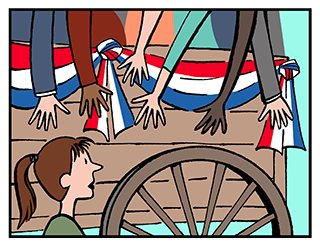Bandwagon

Pepsi is the choice of a generation. McDonald’s has served hamburgers to billions of human beings. Oreo is America’s favorite cookie.
These are all examples of the bandwagon device.
As explained by the IPA:
“The propagandist hires a hall, rents radio stations, fills a great stadium, marches a million or at least a lot of men in a parade. He employs symbols, colors, music, movement, all the dramatic arts. He gets us to write letters, to send telegrams, to contribute to his cause. He appeals to the desire, common to most of us, to follow the crowd. Because he wants us to follow the crowd in masses, he directs his appeal to groups held together already by common ties, ties of nationality, religion, race, sex, vocation… With the aid of all the other propaganda devices, all of the artifices of flattery are used to harness the fears and hatreds, prejudices and biases, convictions and ideals common to a group. Thus is emotion made to push and pull us as members of a group onto a Band Wagon.”1
The bandwagon appeal emphasizes that “everyone else is doing it, and so should you.” Since few of us want to be left behind, this technique can be quite successful. However, as the IPA points out, “there is never quite as much of a rush to climb onto the Band Wagon as the propagandist tries to make us think there is.”
Some readers might chuckle at quaint references to bandwagons, tents, and telegrams, and it is difficult to deny that much has changed since the IPA coined this term. However, this sort of persuasive appeal is more common than ever.
Consider the fact that so many celebrities and politicians are obsessed with the number of online followers. Imagine that a friend shares a startling post from a politician you’ve never heard of. When you follow the link to research the source, you notice that the politician has millions followers, and thousands have shared the tweet. Based on these numbers, you might assume that the post is both credible and important.
This appeal is even more likely to be effective if we believe that everyone else in the crowd is just like us. If Karen from New Jersey likes this product, then I will too. If several houses in my neighborhood have posted yard signs for Candidate X, she must really know what’s best for our neighborhood.
Emerging technologies such as bots and sockpuppets play a vital role in building a digital bandwagon effect. A 2016 study from researchers at the University of Southern California and Indiana University found that approximately 15% of all Twitter accounts are controlled by bots rather than people.2 Facebook acknowledges the existence of nearly 60 million fake user accounts, and a company called Devumi has sold more than 200 million fake Twitter followers to governments, criminals, and entrepreneurs.3
The bandwagon effect helps us understand the rationale for this unsavory behavior. Propagandists use bots and sockpuppets in order to convince people that everyone else really is doing it.
When confronted with this technique, it may be helpful to ask ourselves the following questions:
- What is this propagandist’s program?
- What is the evidence for and against the program?
- Regardless of the fact that others are supporting this program, should I support it?
- Does the program serve or undermine my individual and collective interests?
References
[1] Alfred McClung Lee and Elizabeth Bryant (1939) The fine art of propaganda: A study of Father Coughlin’s speeches. Harcourt, Brace, New York. Pages 105 to 106.
[2] Alessandro Bessi and Emilio Ferrara (2016, November 7) “Social bots distort the 2016 US Presidential election online discussion,” First Monday, 21(11).
[3] Nicholas Confessore, Gabriel J.X. Dance, Richard Harris and Mark Hansen (2018, January 27) “The follower factory,” New York Times.
